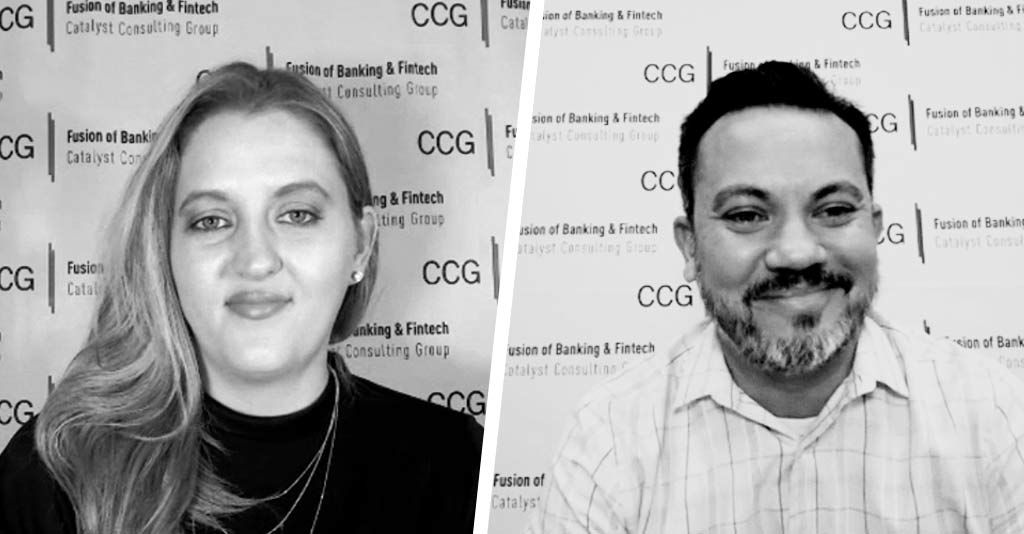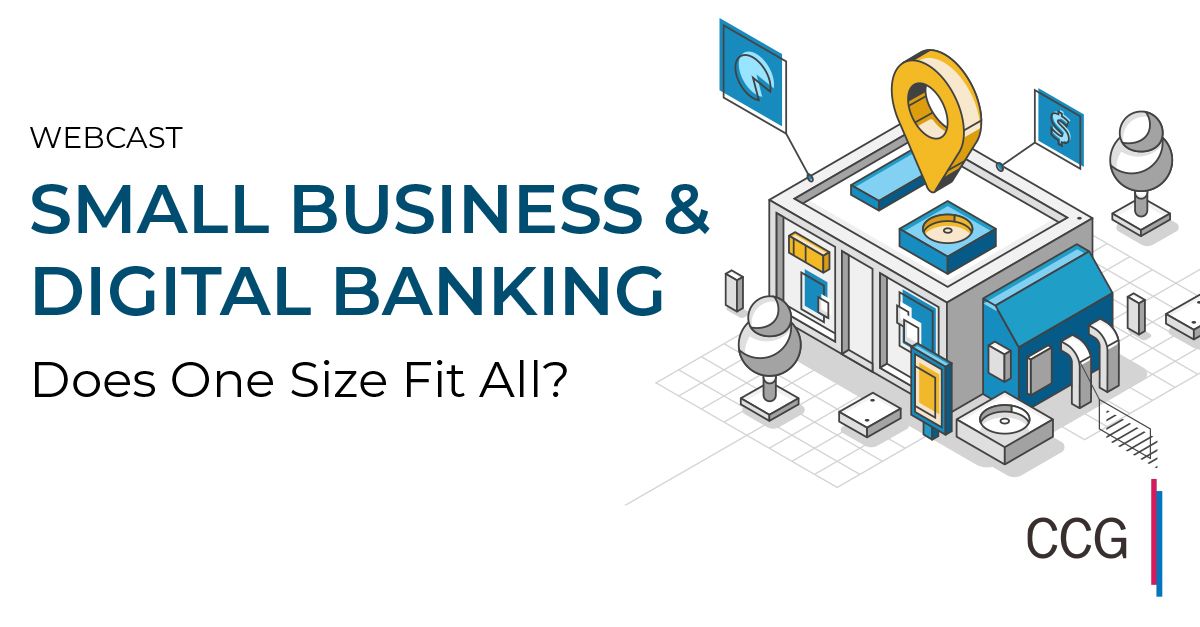Overview
Tony Lazare [00:00:10] Hello, I’m Tony Lazare, CCG’s Digital Technology Manager, and welcome back to the CCG webcast channel. Joining me today is our Managing Director and Chief Strategy and Innovation Officer, Scarlet Sieber. Hello, Scarlett.
Scarlett Sieber [00:00:23] Hey, Tony. How are you?
Tony Lazare [00:00:27] I’m good. How are you?
Scarlett Sieber [00:00:29] Good. Another day, another thing to look at for us, and I’m excited to be talking about digital today, so looking forward to our conversation.
Tony Lazare [00:00:38] Yeah, I’m excited about it, too. So we’re going to be talking about banks and credit unions, digital capabilities, particularly around onboarding. This isn’t a new topic, but Covid-19 has accelerated the demand for both consumers and small businesses related to digital capabilities. With that said, let’s get started with my first question, “Outside of or maybe in response to covid, what else is happening at the macro level that is influencing the way SMBs and consumers interact?”
Scarlett Sieber [00:01:08] There’s a lot, right? I think one of the key things if we look at the macro level is that people are living longer, they’re living longer in new ways and you hear so much attention and energy focused on Millennials or Gen X. But actually, technology is impacting every demographic, every age group, even those that typically have been underserved before, especially in response to Covid. They are now using technology. They’re getting on facetime. They’re using their mobile banking app because they have to it’s unsafe for them to go into a branch. So I’d say that’s number one. Number two, with that technology, people are working across borders. I had an example a few weeks ago, Tony, where I was speaking at a conference in the Nordics in the morning and then speaking at a conference in California in the afternoon because of the idea that technology is everywhere and definitely, that has accelerated post-Covid. Then I would say the third thing is that technology is ubiquitous. It is all around us. You cannot get away from it and people who may have traditionally been going to a branch or may be used to calling up their banker are also shopping on Amazon, are also interacting on the social platforms. So they have expectations around what they want those experiences to look like and they want it to be as seamless as going on Amazon to order something. They want it to be as social or as integrated as their social apps. Technology has really accelerated that movement and so that’s what we’re seeing on the macro level.
Tony Lazare [00:02:48] Thank you. You know, I have Gen Z in my house, young children, and I feel like they were born with a device or tablet in their hand, so, it really is everywhere. So how do those components impact what’s happening with our community banks and credit unions? What does all of this look like for them?
Scarlett Sieber [00:03:09] For them, it’s more responsive to their members or their clients. Right, so you sit back and you think about, there was typically a lot of touch points for your clients where there will be a group of them that were the ones who were studying through or coming into the office or branch once a week to deposit their check or every other week or having that key relationship. But because of that movement to digital, they are now interacting with you in a new way. So I would say, as a response to Covid, we saw, especially on the consumer side, those that prioritized digital, early, were front runners because that transition was much more seamless. They already had it. It was ready to go. So for those clients, they had that really need to make that move, the technology was already there and the team, meaning in this case, the bank and credit unions team, was already equipped to answer and handle those questions. Those who are a bit further behind, who maybe had it as a nice to have it being digital and nice to have versus a must have had a bit of a harder time. I cannot tell you the number of conversations I have with bankers around advice and thoughts on what type of language to use on their websites, on how to to get people who are not used to being on that digital platform there and comfortable, and use it because you maybe are creating and reacting to people with a certain demographic thinking, these are the ones who are going to use it, but now everyone’s using it. So there was a lot of how to and help pages around that, which I think was a big deal. With that, I do see, we saw, a big gap in what was happening on the small business side. Small businesses were really suffering and the capabilities that we have for opening accounts online for small businesses is far behind the consumers and we need to be quicker and better there. Our banks and credit unions need to be prioritizing digital. It’s usually on that list, but maybe it’s a seven or eight on that list of top 10. We need to move that up to a two or three because it’s not a question of when, it’s a question of how quickly we can get there and we need to do it soon.
Tony Lazare [00:05:15] I think we saw with the pandemic, the ones who didn’t have it prioritized high, probably suffered more than most. You know, digital is a really large umbrella so of all the areas within digital capabilities, where did the banks fair best and conversely, where did they fair not so well.
Scarlett Sieber [00:05:37] So I would say, as a community, I was so impressed with many of the responses of the banks and credit unions, we look at things like even PPP, some of the bigger banks, in my opinion, fell short and I had many conversations with friends, with family and with colleagues who were actually moving over and went to get PPPs through their local community bank because it made more sense for them to do that versus going to one of the big banks. It doesn’t respond as well. I would say there were a good group of them, I mentioned this a little bit earlier, but definitely the online account opening and the online capabilities on the consumer side, there were a surprising amount who were ahead. And I think that made a big deal in terms of where there is room for improvement. The onboarding process definitely needs some help. There are a lot of ways to do that and the education component is key. So I’ll give you one small example. I actually wrote about this in an article for Forbes around why small business, online, and mobile account opening fell short. This is actually a consumer example, but it’s all part of the same thing where in terms of what I’m talking about right now, which is, so Venmo, you have a whole new generation who is going to be utilizing Venmo. My mother in law was one of those people and a friend of hers had asked her to pay for some online choral group or dance group that they were doing together. And so she said to me, “Hey, Scarlett, I’ve paid Karen Smith three times on Venmo, but she keeps saying,” I set up the Venmo account for her but that was that and then she said, “I paid her three times but she keeps saying she hasn’t gotten the money.” I’m like really? So I go and look, of course, it wasn’t Karen Smith but it was a similar name. Anyways, there were 10 Karen Smiths. So her friend said, “It’s just Karen Smith, it’s no problem.” It’s like, yeah, but it is a problem because it was Karen Smith, dash one, five, six or whatever and so she’s the one who made the transaction and she made it three times. So I had to go with her and reach out to that other Karen and ask for that money back, which she did not get, by the way, she didn’t have the right to do so. So I would say, we have a responsibility as an industry to educate and inform people how to do these things and I certainly do believe too on the small business side, there was a lot of shortcomings and small businesses are the lifeblood of our economy and we need to start preparing for them now on how to better serve them from a digital perspective. Because some of them are still very traditional as well but they’re moving, their customers are moving to digital. So they have to move to digital. They have to find ways to interact with their customers in new ways and we are the ones who are supporting them have to do the same. That should be a high priority for us.
Tony Lazare [00:08:32] It sounds like the experience is vastly different across these institutions. Why do you think some did better than others?
Scarlett Sieber [00:08:43] I’ve you know, it’s a good question. I’ve sat back and I’ve talked to a handful of players in the ecosystem, some who were all over the news for being front and center and really taking a very, very proactive response and others who kind of got bashed over the head for this and I think it does go back to, “What is your priority and why.” So it’s common for us to have conversations with banks and credit unions to talk about, “Well we’re interested in digital, it’s something that we want to think about, were interested in working with FinTech but it’s a curiosity as opposed to a necessity.” I think we really need to move towards necessity and less on curiosity. I had a really interesting conversation with a credit union CEO, and when we were speaking, she was talking about her objectives for 2021 and the objective she had set with her board. And profit or rather revenues for the first time wasn’t number one. It was about meeting the members where they are and moving to digital as fully digital as possible from a digital integration perspective. So, the board has a huge role to play here too. The executive team has to be on the same page, but the board, the board signing off on and prioritizing digital is crucial.
Tony Lazare [00:10:08] That’s a dramatic and interesting shift away from revenue.
Tony Lazare [00:10:13] Looking ahead, what are three things that you would say a community bank or credit union must have in place to compete?
Scarlett Sieber [00:10:22] Oh, boy, so many things. I would say, a strategy, a plan, being on the same page about why so you want to do this, you want to compete, who are your competitors? How do you think about competition? It may be different than what you expect. It’s not always that bank or credit union down the street, but the same geographic territory as you. It can be that next FinTech or whatever else. So being very clear about what your plan is and strategy and why the motive behind it. I would say number two is and Tony, for those of our viewers who have watched our other webcasts or heard me talk about this, this is a passion of mine so I’ll definitely mention it here. Culture, a culture that actually embraces digital and prioritizes innovation, that means a lot. We can have hours and hours of conversation around this, but really. You know, you have the plan, you have the strategy now you have to have a culture, you have to let people in the organization from the executive teams, a lot of business leaders down, know-how and why this move to digital, this transformation, is impacting them for the better and how it’s going to make their lives easier and make their members and clients’ lives easier and you have to have the right partners. We at CCG are big believers in the fusion of banking and fintech. We are the bridge builders in many ways. That’s what my thoughts and the rest of the executive team talk about all the time and partnership is key. Trying to reinvent the wheel and be the best at everything is not the best way to move forward for our institutions that are on the smaller side, that are reliant on the core. It can be a bit more challenging, but there are ways to get creative about partnerships with very, very minimal integration so that you are offering your clients and your members the best of what’s out there. So I’d probably say those are the three things that come to mind.
Tony Lazare [00:12:22] You know, for those just getting started, what does that look like?
Scarlett Sieber [00:12:30] So it is looking at and listening to things like this, looking at the macro-level of the ecosystem to understand where in the industry we’re going. It’s about spending time and analyzing your members and your customers, where are they now, where are they going? Having a conversation with an institution in the Southwest and as a response to Covid, people from California were coming over to their state. Also in response to Covid, people in their state were going to other places.
Scarlett Sieber [00:13:09] So it’s having an idea of who your client is today, why they’re your client and how do you keep that relationship? Now, geographic borders are shifting more than ever before. People are working from home. So they may be leaving your state, they may be leaving your area. How do you keep them as a client? What does that actually look like? What is the data telling you as you start looking through that and the best way to do that is to spend time not with the executive team, but with your frontline staff. What are those conversations there? How are they interacting with your clients and your members? What are they telling them? Truly get an idea of who they are, because by doing that, you can then tie them into the strategy that goes into the cultural fit, the cultural strategy as well and having the right partners to do that, I would say, are some of the key things. And then not only focusing just on the line of business leaders but making sure that you have what can sometimes be impediments for these things moving forward, compliance risk, legal, and procurement. All of those processes. Get them involved in the process and get them involved early so you don’t have to go and create everything and build it yourselves. But start having the conversation with those teams. Talk to them about the vision of what it is you want to do and why and how. What are the things that we need to be thinking about from a legal compliance and risk perspective and have those people be the advocates for these initiatives, not the naysayers and that takes a little bit of work but it’s certainly possible. I’ve seen it be implemented more than once with even titles like, “Risk Innovation.” It seems like an oxymoron, but it exists, they definitely exist.
Tony Lazare [00:14:55] That’s great information, Scarlett. I appreciate it. That concludes today’s webcast. I’d like to thank everyone for tuning in. If there are any follow-up questions or you’d like to reach out to Scarlett. You can click on the Q&A button right below the images and we’ll see you at the next CCG webcast. Thank you.
Scarlett Sieber [00:15:15] Thanks, Tony, and I would like to share one last thing with all of you. This is an intimidating process but there are people out there like CCG that can help you make it a little bit easier and we would be more than happy to have an internal conversation. Just talk about your fears, talk about what’s going on, and we truly want to be valuable and add to the ecosystem as a whole. For the FinTechs who are listening too, we have lots of thoughts for you as well.
Business Continuity: Unlocking Digital Commercial Banking Capabilities
Financial Brand Article: Over the COVID Horizon, Mobile Banking Demands Strategic Clarity
Digital Dreams – Expanding Commercial Banking Capabilities
The Digital Ultimatum – A Catalyst for Change
Financial Brand Article: Is It Finally Time for Open Banking’s Debut in America?

Scarlett Sieber
Managing Director, Chief Strategy & Innovation
CCG Catalyst Consulting Group
Chief Strategy & Innovation Officer Scarlett Sieber is one of the world’s premier voices in financial services. She is among the industry’s most sought-after speakers as a thought leader and innovator with expertise in driving organizational change at both startups and enterprises across the financial services and fintech ecosystem. Scarlett has been invited to speak at over 100 prestigious financial services and technology conferences globally, including Money20/20, Finovate, South Summit, and NASA’s Cross Industry Innovation Summit.
Scarlett’s experience includes founding her own startup as well as working at banks such as BBVA, USAA, and Opus Bank. She is a leading fintech influencer, included on lists such as Top 100 Women in Fintech 2019 and Top 10 Fintech Influencers in the U.S. Scarlett also has deep experience in digital strategy and innovation implementation, making her a key asset to building cutting-edge programs for our clients.







